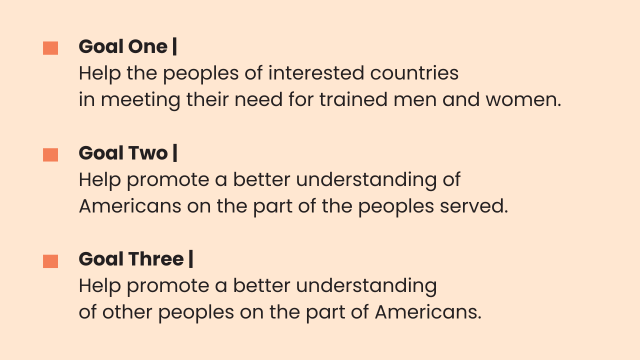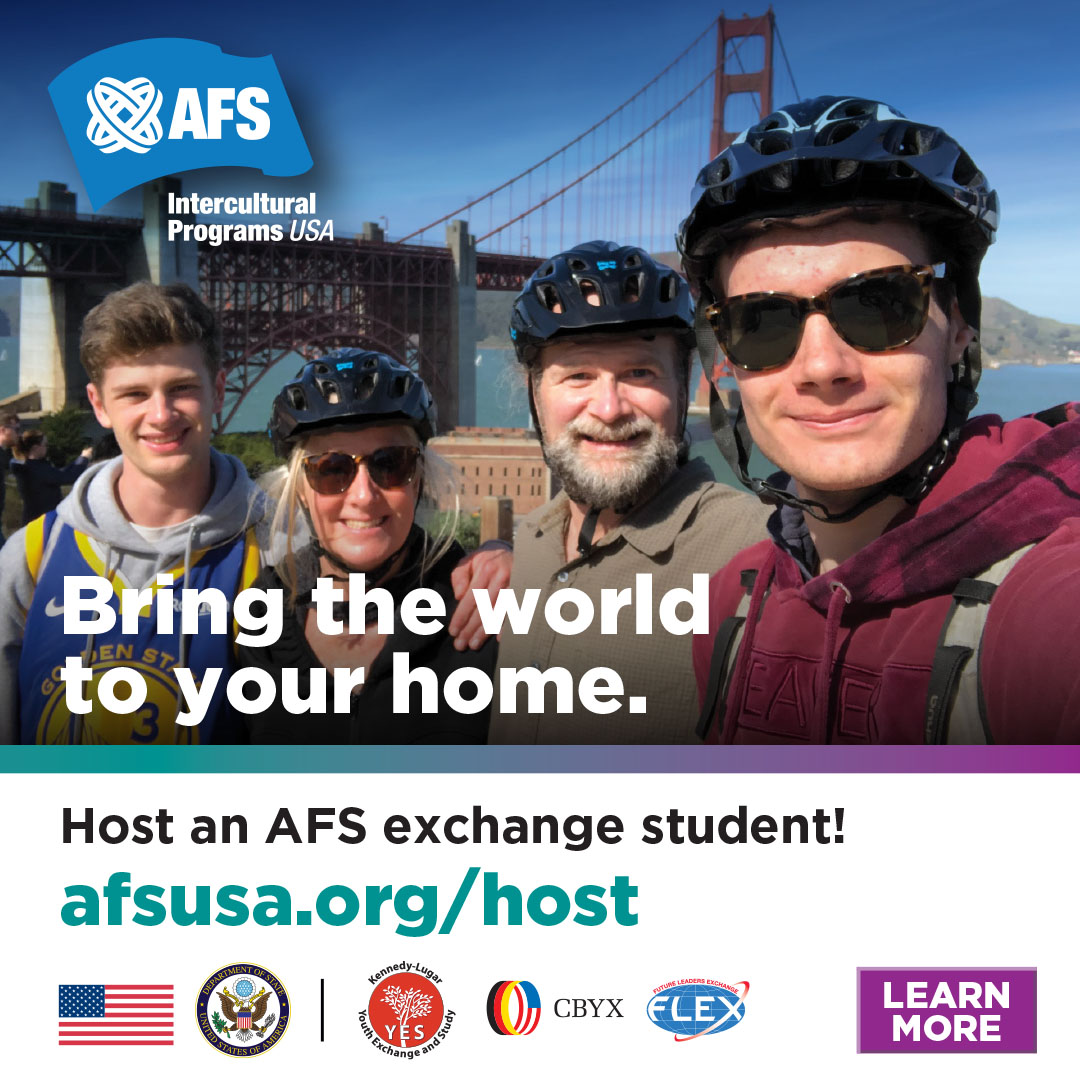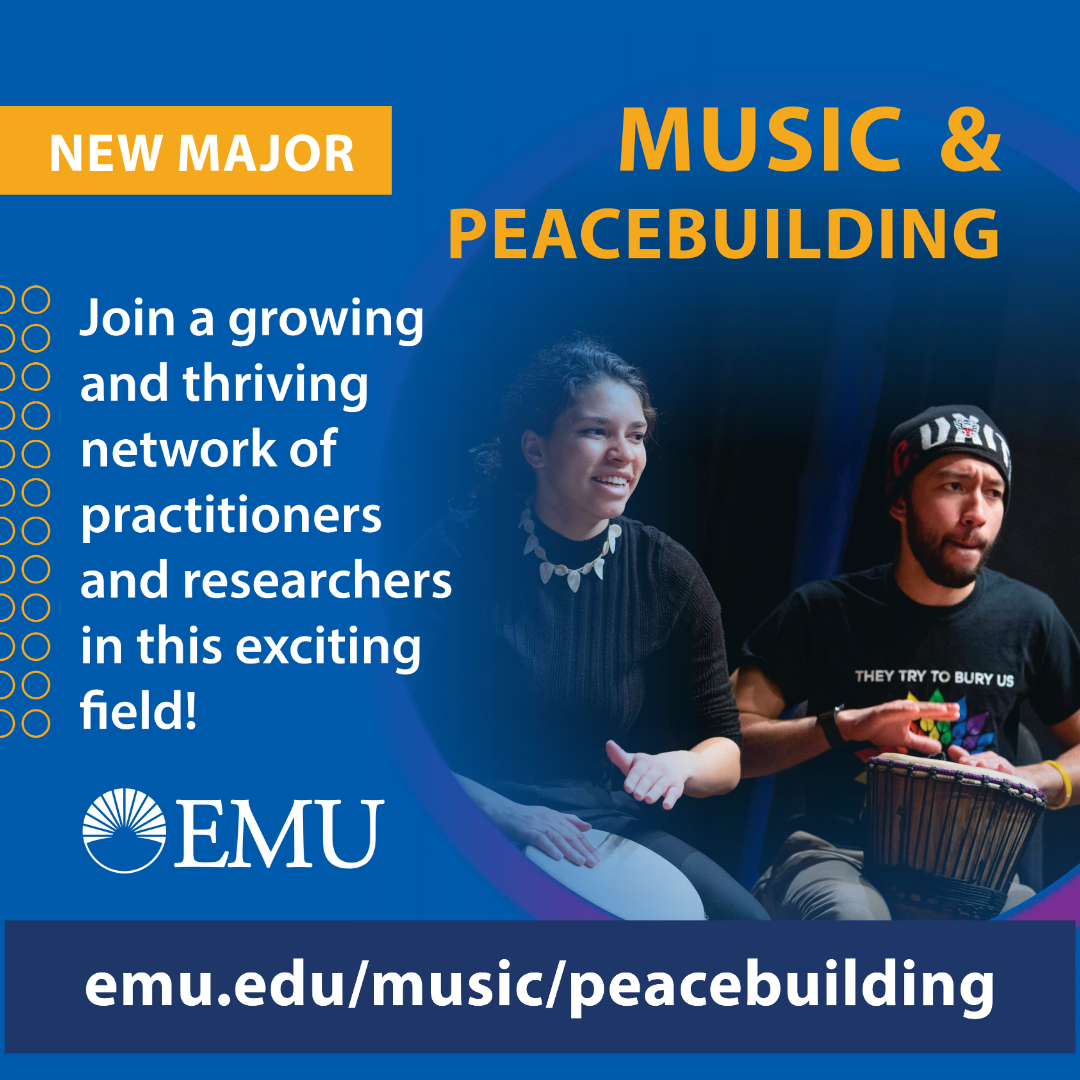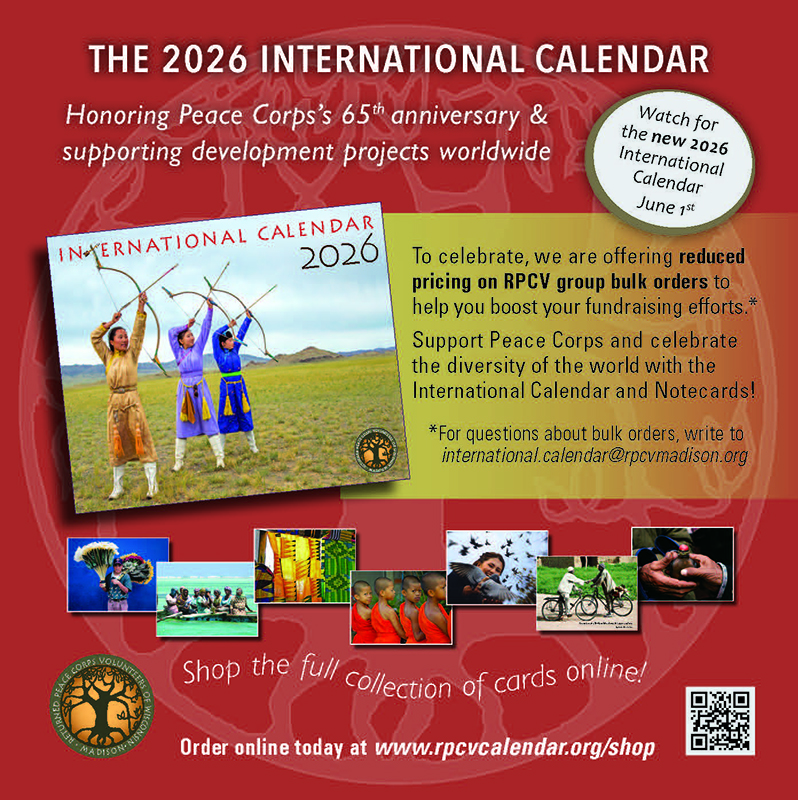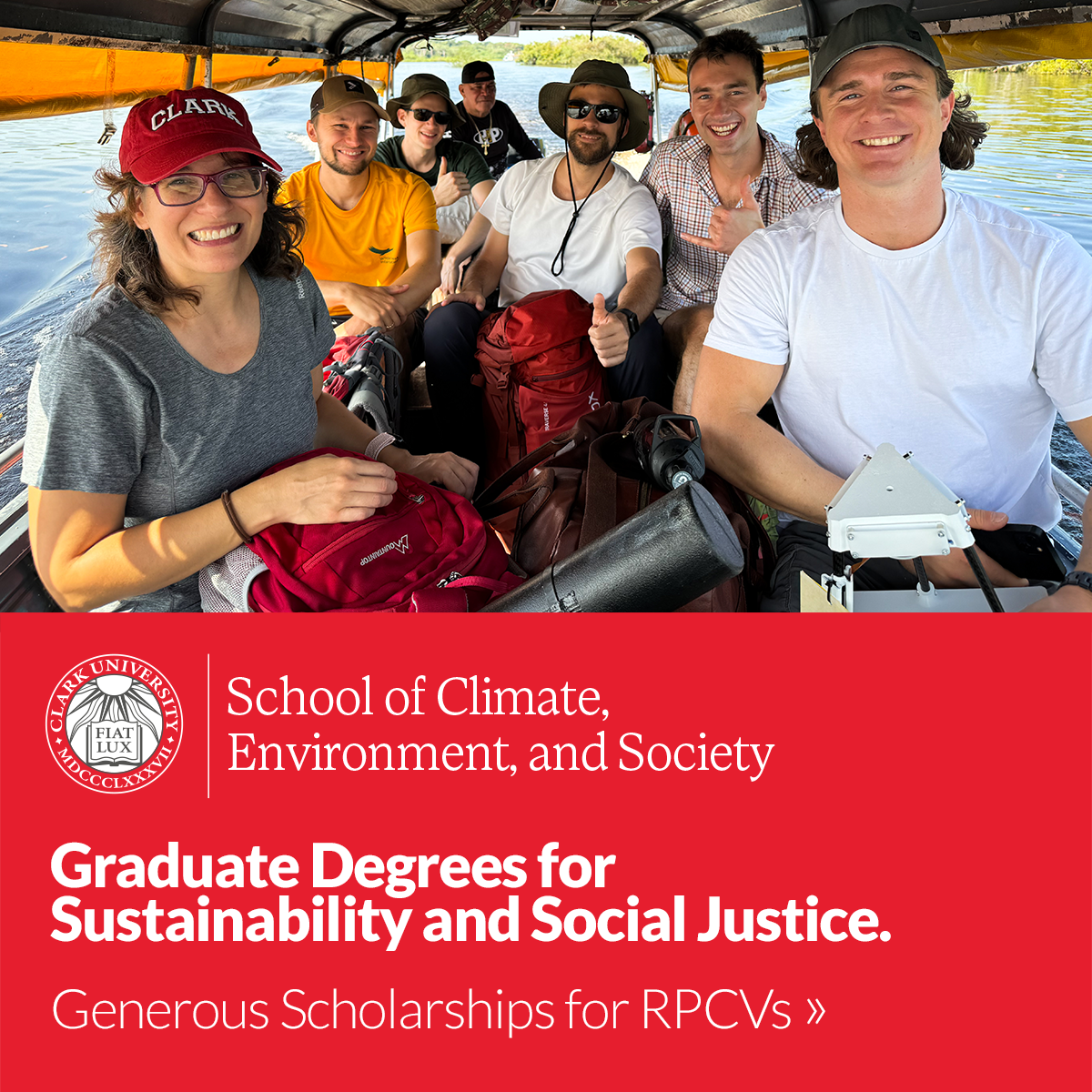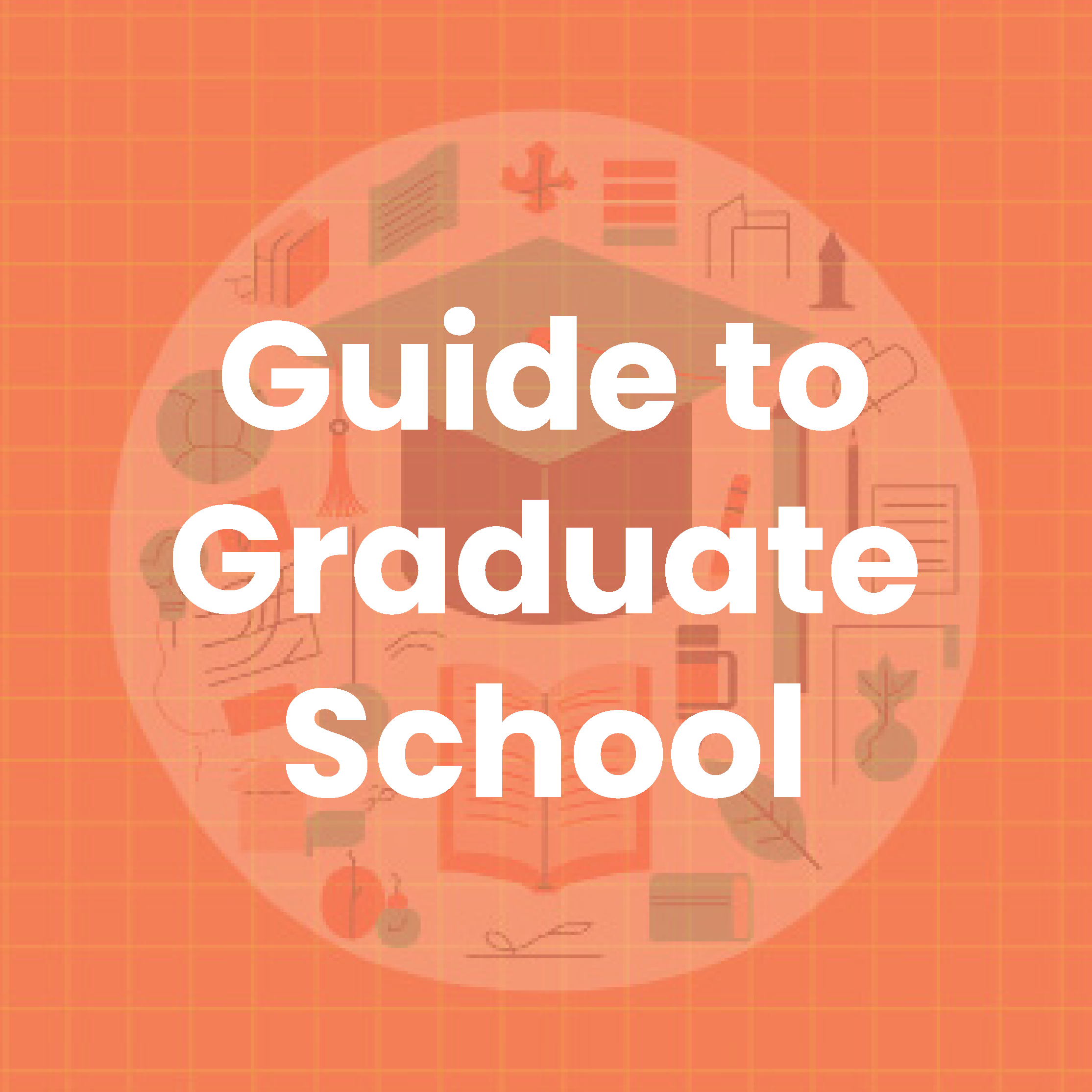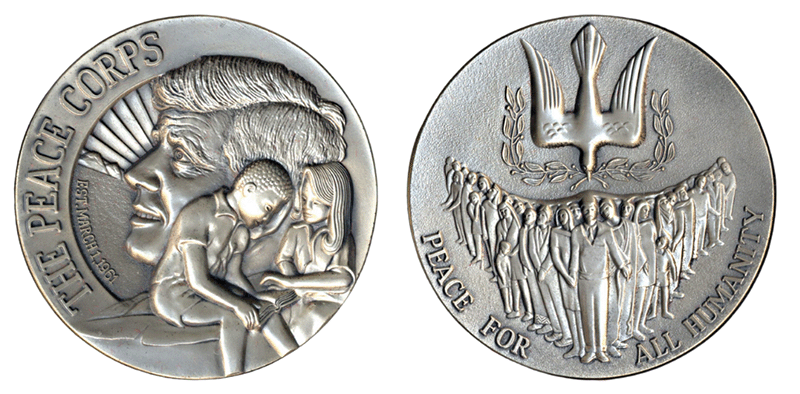
Return on Investment
An in-depth report commissioned by NPCA provides empirical data on the benefits of Peace Corps.
Editor’s Note
As federal funding for international aid and cultural exchange programs continues to shrink, policymakers are increasingly asking whether these initiatives deliver tangible benefits to Americans. In 2021, National Peace Corps Association commissioned a major study to mark the Peace Corps’ 60th anniversary. The result—The Domestic Dividend of Peace Corps—was published in 2023 and stands as the most comprehensive analysis to date that demonstrates how Peace Corps service benefits communities back home. What follows is an executive summary, as written by the task force.
Preface
In August of 2019, two of my 1960s PCV friends, Art Flanagan, and Randy Adams, and I met on my back patio to discuss the upcoming 60th anniversary of Peace Corps. We thought the time was ripe to explore the extent to which President Kennedy’s idea in 1961 had been realized—that the Peace Corps would have a domestic benefit. The implication was clear that President Kennedy expected Peace Corps to show a return on the investment in Peace Corps Volunteers’ work abroad. We worked up a proposal to the NPCA to study the “dividends” that have been paid. It was soon approved, and NPCA formed a task force of RPCVs and former Peace Corps staff to study the question. After four years and over a hundred meetings of the Task Force working diligently in a volunteer capacity, we are pleased to share the resulting report, The Domestic Dividend of Peace Corps. We dedicate this survey to the American people who have supported this idea called Peace Corps. They have done so with their treasure and their sons, daughters, mothers, fathers, and grandparents, resulting in over 250,000 PCVs, who represent every ethnicity, gender, and age, in service to over 120 developing nations.
K. Richard “Dick” Pyle, Ph.D (Jamaica 1966–68); Peace Corps Field Assessment Officer/Training Center Director, Puerto Rico (1969–72); Country Director, Eastern Caribbean
(1990–93); NPCA Board member and Board Chair (1997–2002); and Special Services Officer and Counseling Outreach Officer (2002–12) is the Task Force Chair.
Task Force members: Richard Pyle, Chair; Glenn Blumhorst; Dan Baker, CEO, NPCA; Randolph Adams; Art Flanagan; Stephen Gastyer; Raymond A. Jussaume; Janet Kerley; Kayleigh Ward.
Executive Summary: The Domestic Dividend Report
1. Introduction
From its inception, Peace Corps has sought to achieve three goals. The first two goals define the mission of the Volunteers’ work abroad. The third goal sets up the aspirations for RPCVs’ contributions upon returning home.
These three goals of Peace Corps have proven to be powerful guidelines in the agency’s efforts to create true and lasting peace, and are the framework for the questions in this study. President Kennedy envisioned both global and domestic benefits when Peace Corps was founded in 1961. The goal of the study was to assess more specifically the degree to which the United States has received domestic benefits from the RPCVs’ service overseas.
The study focused on two specific questions.
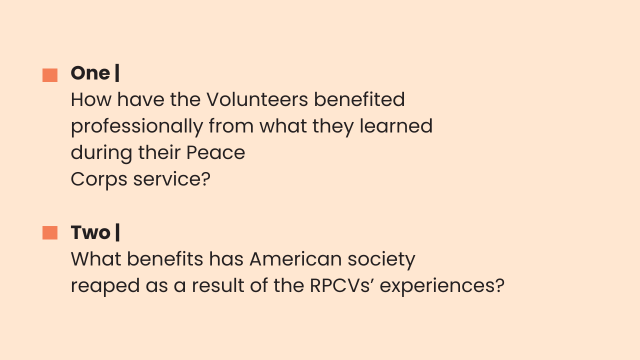
Task Force members assumed, based on anecdotal evidence and earlier studies, that service as a Peace Corps Volunteer is a transformative experience which changed RPCVs in positive ways and supported their ability to give back to their own country. The Task Force members designed a survey to assess this assumption. A second expectation was that the study would identify the breadth
and depth, where possible given the limitations of the survey, of the domestic benefits of RPCVs’ domestic contributions. The study distinguished between Goal Three activities promoting a better
understanding of other countries and cultures on the part of Americans, and other possible domestic benefits. The team hypothesized that Goal Three activities are but one of many domestic benefits.
This report builds on a small body of academic and policy literature about the impact of PCVs in host countries and the impact of Peace Corps service on Volunteers. Some studies reviewed RPCVs’
individual career paths, but few focused on the larger scope of the domestic benefits.
In comparison to the work done over the past 60 years, this study is the largest, broadest, and most comprehensive endeavor to evaluate the domestic benefits of the Peace Corps experience.
This does not devalue historic work on PCV’s and RPCV’s experiences, impacts, and skill development; this study helps to further clarify the effects of Peace Corps on RPCVs and the American public.
A unique contribution of this study is evaluating the domestic benefits from RPCVs who span all six decades (1962–2021), enabling us to examine the paths of the earliest Volunteers over six decades as well as the contributions of those who have served recently.
The main themes by chapter follow below.
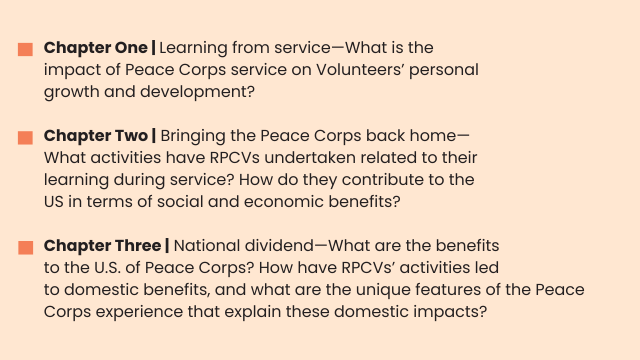
In this summary report, we highlight the key findings and insights from each chapter to demonstrate the influence of the Peace Corps experience on RPCVs and the subsequent benefits to the American public upon their return.
The Task Force designed and completed a survey instrument in September 2021 and sent the questionnaire by email to 60,000 RPCVs. The questionnaire contained 43 questions to measure RPCVs’ skills gained from service and the numerous ways in which they used these skills to achieve domestic impacts. We received 4,090 responses with 90 of those who responded completing the survey in its entirety. The data were collected using Qualtrics software and analyzed with Stata. The methodology and the demographic data for survey respondents are described in Annex B of the full report.
2. Learning From Service: What Volunteers Bring Home
Personal growth and development
- A majority of RPCVs reported greater intercultural awareness (96 percent), more confidence (92 percent), being more accepting of diversity (87 percent), a greater interest in service (86 percent), more awareness of the value of community (86 percent), and greater awareness of professional goals (67 percent) following their service.
- The majority of RPCVs credited the Peace Corps experience with helping them develop a newfound confidence in their own abilities, establish the foundation to learn a different language and culture, develop leadership and critical thinking skills, weather uncertainty, and adapt to life and work in different social environments.
The overall experience led individuals to reevaluate their goals and decisions for their post-service lives.
Serving in the Peace Corps helped me understand the depth of my own strength and capabilities. I became more confident and assertive. I enhanced my communication
skills and became practiced in setting honest expectations while conveying determination and hope.
Skills Development and Life Skills
- A majority of RPCVs reported that their Peace Corps experience enhanced their intercultural awareness (84 percent), resiliency (74 percent), problem-solving (53 percent), and communication skills (52 percent).
- A smaller minority of RPCVs reported their Peace Corps experience enhanced their leadership (42 percent), teamwork (39 percent), and coalition-building skills (33 percent).
- A majority of RPCVs reported that their Peace Corps experience directly influenced their interest in understanding global issues (83 percent), desire to have influence in the lives of others (71 percent), interest in promoting diversity, equity, and inclusion in their community (58 percent), and volunteering in their community (52 percent).
- A minority of RPCVs reported that their Peace Corps experience directly influenced their career paths (46 percent), and entrepreneurial skills (23 percent).
3. RPCVs as Professionals: Applying the Lessons of Peace Corps
Sharing the Peace Corps experience with the U.S. public
- A majority of RPCVs (90 percent) shared their Peace Corps journey with the U.S. public. A third of the RPCVs (30 percent) shared their Peace Corps experiences through teaching and training/coaching. These activities also included formal presentations about Peace Corps, writing, and using social media to share their stories.
Links between service and career choices
- The 4,056 RPCVs worked in eleven technical areas during their project assignments. Over a third worked in education (37 percent). A smaller number worked in agriculture, forestry, and fisheries (13 percent), health and nutrition/sanitation (14 percent), and community development (11 percent).
- The RPCVs worked in 14 different career fields after service. The top five fields were social services (16 percent), other (14 percent), youth (13 percent), public service, government, law, and policy (11 percent), and community development and outreach (11 percent).
- Half of the RPCVs across multiple sectors pursued a career field either related to or associated with their Peace Corps project assignment. A majority of RPCVs who had served in the following sectors continued to work in that sector upon return to the U.S.: business (55 percent), education (63 percent), environment (54 percent), and government and/or public service (68 percent).
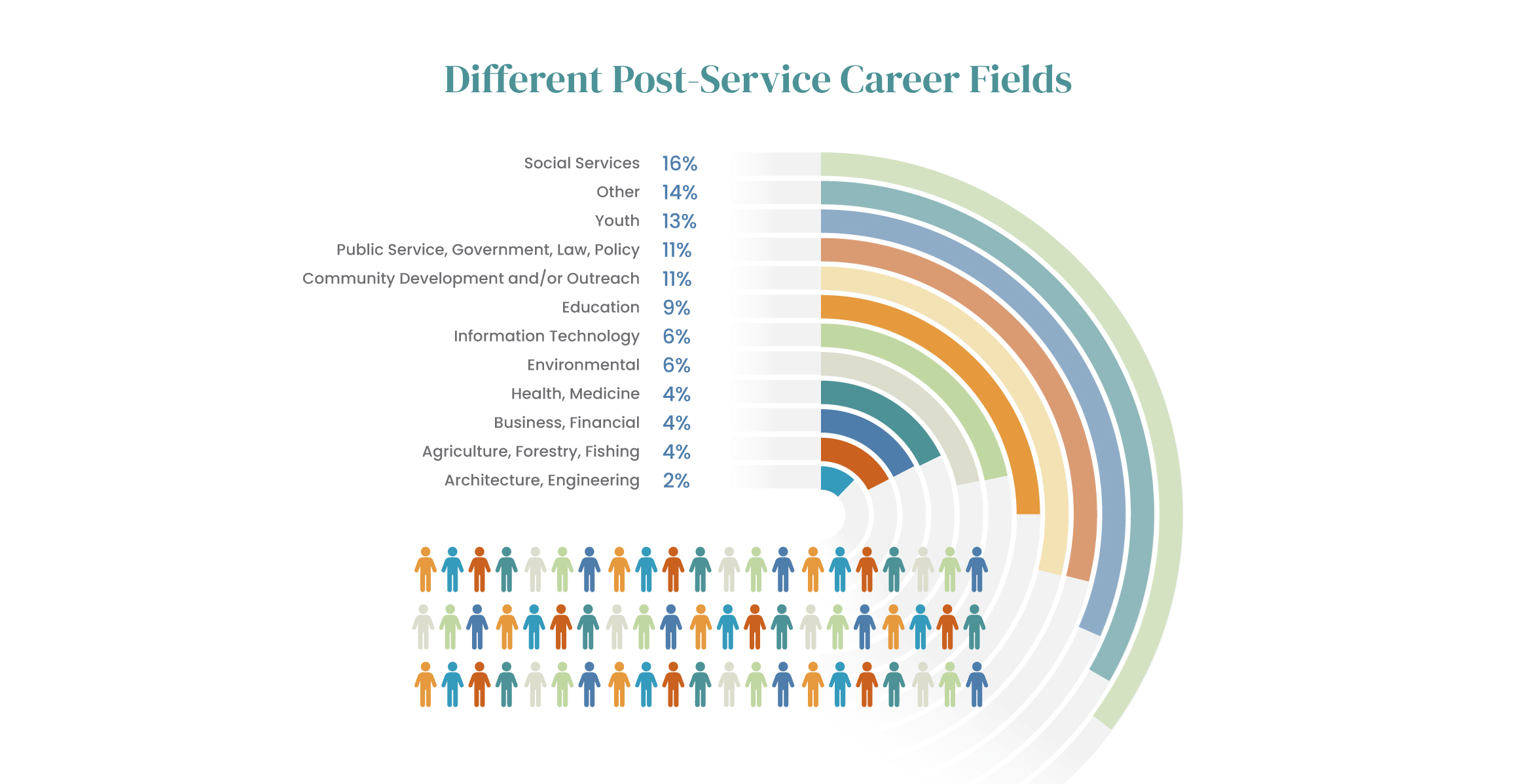
Application of new knowledge to careers
- A majority of RPCVs reported that they have used their knowledge in their professional work (74 percent) either daily, weekly, monthly, less than monthly, or in the past. These included languages (67 percent), cultural knowledge (86 percent), political system knowledge (72 percent), and economic system knowledge (70 percent).
- Overwhelmingly, RPCVs indicate that the soft skills they honed during Peace Corps were more significant than specific content areas.
Summary of the major areas of influence of Peace Corps on RPCVs’ careers
- Most of the respondents noted that the opportunity to confront new and unique challenges and cultures was clearly the most rewarding aspect of their Peace Corps work.
- RPCVs reported that their Peace Corps assignments gave them access to situations that enhanced their career development. This was due in large measure to their unique status in a developing country, often in remote areas where their skills were needed.
- The RPCVs said they were better able to fully use their talents and take on unique roles and leadership opportunities at an early stage in their career, opportunities that would not have been possible within the U.S.
Special Case: Entrepreneurship
- Twenty-four percent of the respondents (933 of the 4,090 respondents) reported that they started a single or multiple successful
ventures (e.g., for-profit and/or nonprofit). Individuals who founded a business venture fall into two groups in terms of the type of influence Peace Corps contributed to their decision.- The first group of RPCVs reported that their Peace Corps experience directly influenced their decision to create a business or nonprofit in the locations they served or in their home communities in the US. The impetus for these ventures came from a basis of service, such as addressing a social or economic problem, rather than
simply being created for financial gain. - The second group found the skills and knowledge they gained through their Peace Corps experience were instrumental in creating their nonprofit and/or for-profit. In this case, social networking and other on-the-ground knowledge from their Peace Corps service provided key resources for starting their venture.
- The first group of RPCVs reported that their Peace Corps experience directly influenced their decision to create a business or nonprofit in the locations they served or in their home communities in the US. The impetus for these ventures came from a basis of service, such as addressing a social or economic problem, rather than
- A majority of the 933 ventures were small businesses with less than $500k in profit (64 percent). A minority of the 933 ventures were large businesses or transnational businesses (36 percent) and reported between $500k to over $10 million in profit.
- Of the 933 who reported founding a business, 724 remained in business as of 2021.
- Based on a rudimentary estimate, the economic impact of entrepreneurial RPCVs during the collective height of their ventures were somewhere between $752 million and $1.1 billion.
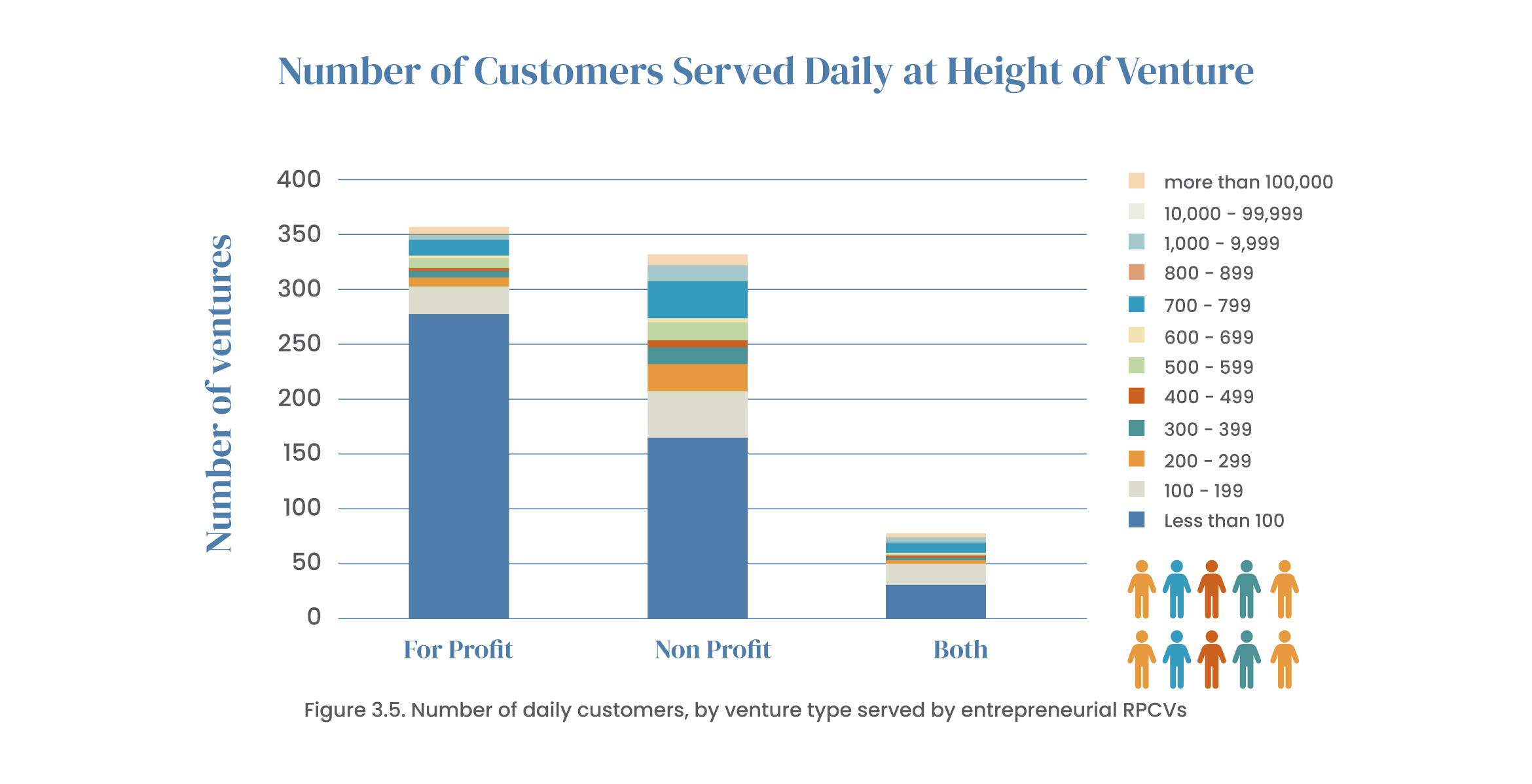
4. Volunteerism as a Domestic Benefit
Bringing service home
- Volunteering upon returning from service is a hallmark activity reported by both younger and older RPCVs.
- Eighty-six percent of the RPCVs (3,510) reported that they continued to volunteer, participating in nine distinct types of volunteer work.
- The top three types of groups were civic organizations (17 percent), groups that work with disadvantaged populations (16 percent), and faith-based groups (12 percent).
- Approximately 88 percent of RPCVs who reported volunteering participated in two or more types of volunteer work after their service. n Regardless of RPCVs’ decade of service, most have similar rates of volunteerism in terms of average weekly hours.
- Regardless of RPCVs’ decade of service, most have similar rates of volunteerism in terms of average weekly hours.
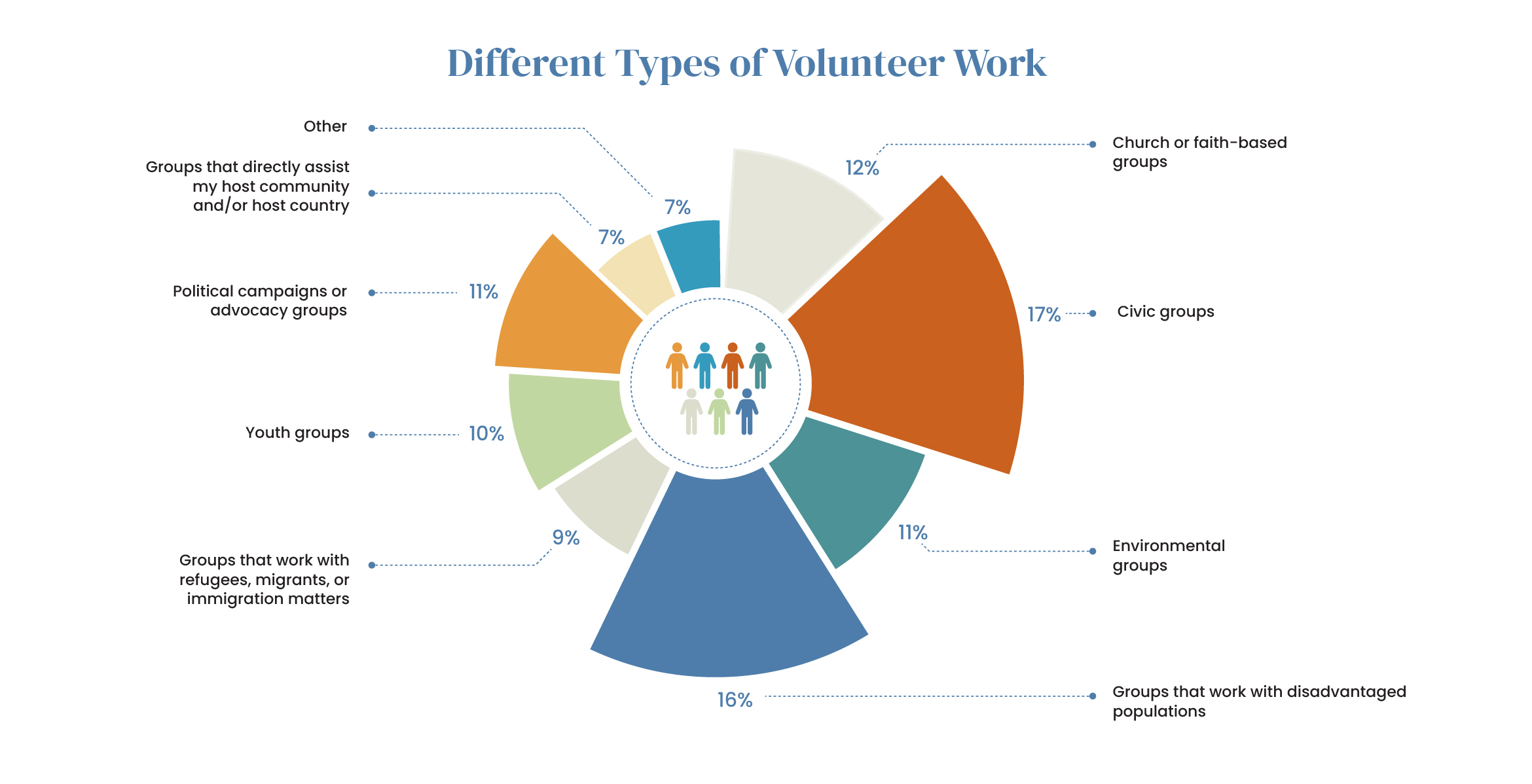
- RPCVs provide significant unpaid work to organizations, and the social and economic impact of this work is high, given the amount of volunteer hours served by RPCVs. Even when considering the more conservative estimates of each bracket of volunteer hours, the reported volunteer work is worth over $1 million each year.
- The rate of volunteerism among RPCVs has increased over time, based on a comparison with the rate of volunteerism reported in the three previous major impact studies of RPCVs.
- In 1969, Harris reported that 27 percent of the volunteers who responded to her survey continued their volunteer activities upon returning. In 1996, the number had nearly doubled, to 47 percent. A bibliography of all the resources cited in this summary can be found in the final report.
- Eighty-six percent of the RPCVs continue to volunteer, nearly double the amount from the 1990s.
- Of the 3,702 who reported that they volunteer, 67 percent have served in a leadership capacity on either a single or multiple boards.
RPCVs are three times more likely to volunteer than the average American.
5. Summary: The National Dividend
America needs the Peace Corps
Knowing that RPCVs have and continue to benefit from the Peace Corps experience leads to the essential question of the study, initially posed by Sargent Shriver. What does the U.S. “get out of the investment in Peace Corps” upon the Volunteers’ return? We know from this study and its predecessors that we “get” U.S. citizens who are more globally aware and committed to service.
The results of this study demonstrate that the overwhelming majority of the RPCVs were led by their changed perspective to solve problems in the U.S. and globally in their professional careers and public service.
- The benefits U.S. society reaps are multifaceted and have a monetary value. For example, the estimated value of RPCV businesses is substantial as is the imputed value of volunteer service. However, the salient outcome of our study is that domestic benefits are both social and economic, and persist over the lifetime of RPCVs.
- The benefits are real in terms of civic engagement. RPCVs continue their mission to serve after leaving their host countries. RPCVs volunteer at a higher rate than that of a comparable segment of the U.S. population, and the potential monetary value of this work, as well as the social impact of this work throughout the diverse communities they serve, is high.
- The benefits are real in terms of intangible effects. Often, the entrepreneurs built businesses to solve social and economic problems they first encountered as Peace Corps Volunteers. RPCVs acknowledge that their service as Peace Corps Volunteers had a direct influence on their lifelong commitment to volunteer at home, and the diversity and scope of their work, as reported in their written stories, are far ranging throughout American society. And it is based on the value of serving others and giving back, as described by one of these extraordinary RPCVs. “My Peace Corps experience had embedded volunteerism into my daily life while doing ordinary things. Our experiences show society the value of volunteer service for a community and for the individual.”
- The benefits are real in terms of international influence. Thousands of RPCVs have dedicated their lives to working in the international arena, bringing a global perspective to their labor, while continuing to represent and serve the U.S.
While many RPCVs are exceptionally notable, the domestic impact of all RPCVs, as a collective, stretches far beyond this group. Thousands of less visible RPCVs are equally as remarkable and dedicated to serving throughout all aspects of U.S. social, political, others and teaching those around them. They bring home the same respect for others learned in Peace Corps and achieve the same catalytic effect seen in the collaboration between Volunteers and host country nationals. It is this catalytic effect of 250,000 RPCVs serving in all walks of life that is quietly changing lives in the U.S.
The Peace Corps Volunteers’ impact upon return spans the local to the global, from serving their home communities in small but impactful projects, to leading federal agencies that improve our connections with the international community. They continue to uphold Peace Corps values throughout their lives, to the benefit of the American people.
This study builds on earlier RPCV studies by revisiting the impact of Peace Corps on its Volunteers. Yet it reaches beyond the well-documented individual benefits to demonstrate the link between RPCVs’ Peace Corps experience and subsequent professional and personal contributions to the larger community.
These are the domestic benefits of the investment made in the 60-year-old experiment in a genuine search for peace.
Task Force members: Richard Pyle, Chair; Glenn Blumhorst; Dan Baker, CEO, NPCA; Randolph Adams; Art Flanagan; Stephen Gastyer; Raymond A. Jussaume; Janet Kerley; Kayleigh Ward.
Related Articles
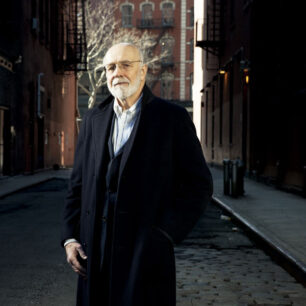
Made in America
Charlie Clifford (Peru 1967–69) is the founder of Tumi Inc., a global travel luggage brand, as well as Roam Luggage.…
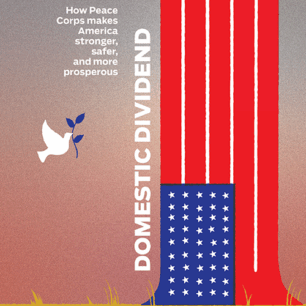
Spring/Summer 2025 Issue
This special issue of WorldView makes the definitive case for how Peace Corps makes America stronger, safer, and more prosperous.
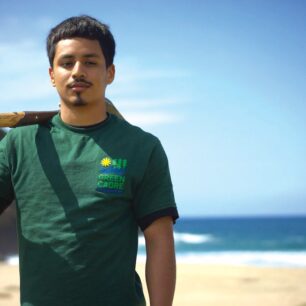
“Bigger Than Peace Corps”
California Service Corps is the largest state-based service program in the U.S. , with more than 10,000 volunteers across the…
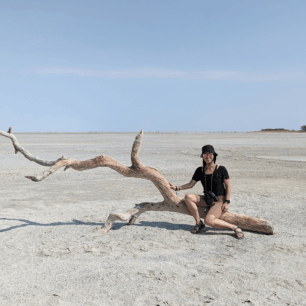
Signal Boost
The digital world is awash in voices seeking monetary reward or improved social status, as the online acronym goes, IRL…


